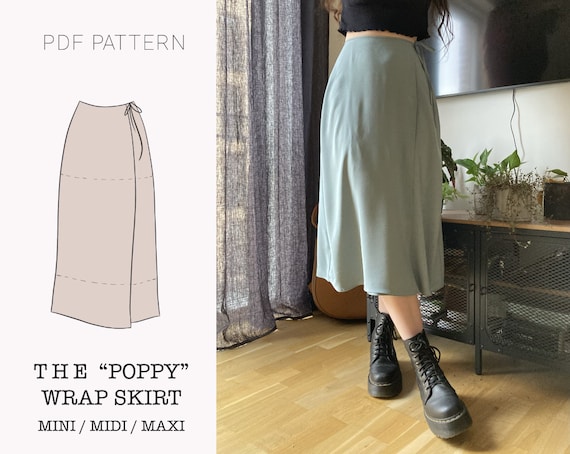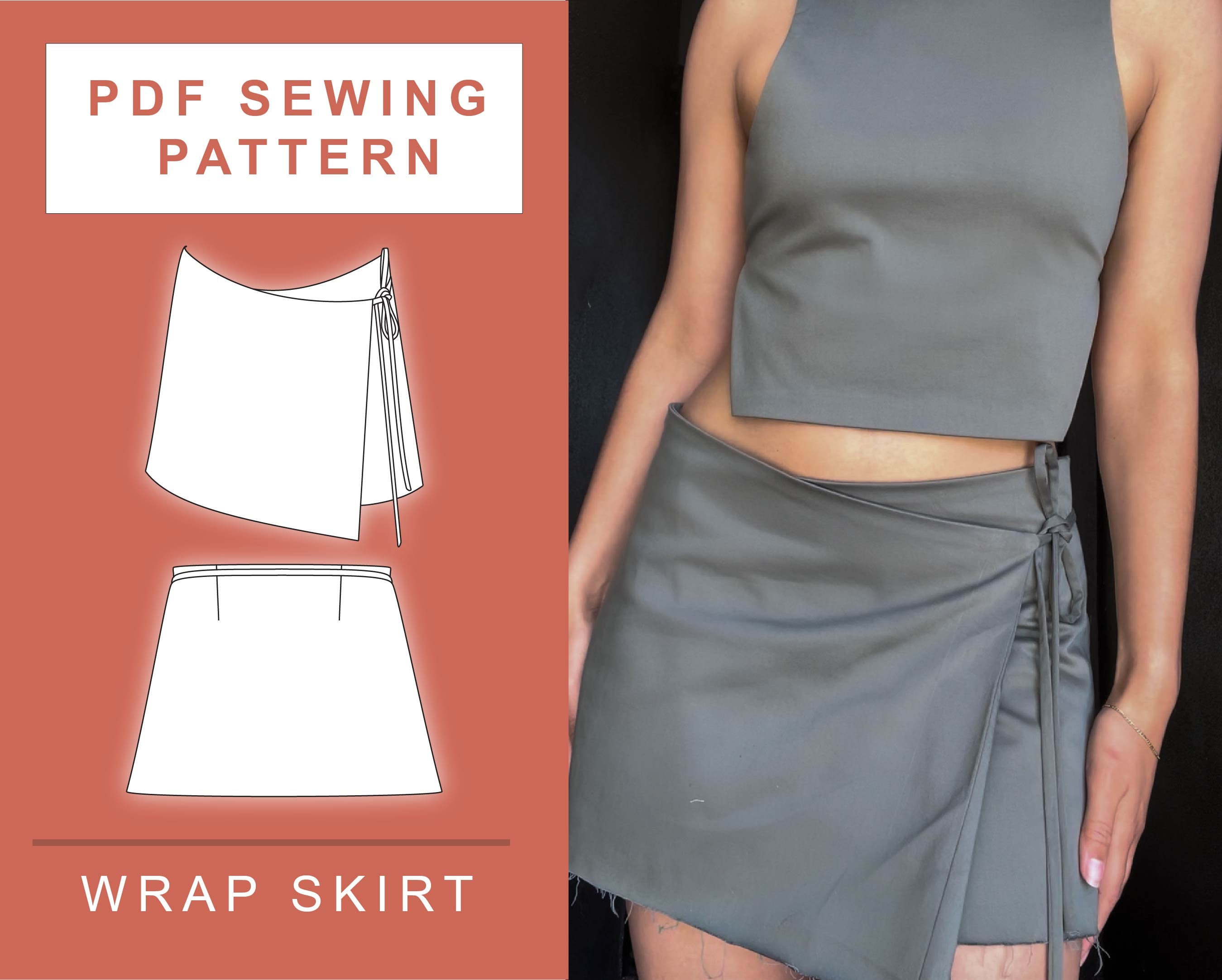Wrap Skirt Sewing Pattern: Create Your Perfect Summer Wardrobe
As the sun climbs higher and the days stretch longer, the quest for the ideal summer garment becomes a delightful obsession. In a world of fleeting fashion trends, the wrap skirt stands as a timeless testament to elegance, versatility, and personal expression. This isn’t merely about adding another piece to your closet; it’s about mastering a craft that empowers you to design comfort and style tailored precisely to your form. The journey begins with a single, powerful tool: the wrap skirt sewing pattern. By embracing this blueprint, you unlock the door to a wardrobe that moves with you, breathes in the heat, and reflects your unique aesthetic. Forget the constraints of mass-produced clothing; here, you are the designer, the architect of your summer silhouette.
The Timeless Allure and Functional Design of the Wrap Skirt
The wrap skirt’s history is as rich and flowing as its silhouette. Its design principles are rooted in garments worn for millennia across various cultures, from the Indian sari to the Japanese kimono, demonstrating a universal solution to the need for adjustable, comfortable clothing. Scientifically, its appeal can be deconstructed through the lens of biomechanics and textile science. The defining feature of any wrap skirt sewing pattern is its lack of a fixed waistband, replaced by overlapping fabric panels secured with ties. This design creates a variable fit that accommodates fluctuations in the body, a concept supported by ergonomic studies which emphasize the importance of non-restrictive clothing for comfort and circulation. The diagonal line created by the wrap is not just aesthetically pleasing; it’s a visual trick often discussed in art and design theory, known to be more dynamic and flattering to the human figure than straight vertical or horizontal lines. As the renowned designer Diane von Fürstenberg, who popularized the wrap dress, famously stated, “Feel like a woman, wear a dress!” This sentiment captures the empowering essence of the wrap design—it celebrates the female form without confining it. The pattern itself is a study in efficient geometry, often requiring less fabric than a fitted skirt and minimizing waste, a principle valued in both sustainable fashion and practical home sewing.

Decoding Your First Wrap Skirt Sewing Pattern
For the uninitiated, a sewing pattern can appear as an arcane map filled with hieroglyphics. However, understanding its language is the first step toward sartorial independence. A typical wrap skirt sewing pattern will consist of several key components: the main skirt panels, a facing for the waist and ties, and detailed instructions. The instructions are your Rosetta Stone. They guide you through the process, from laying out the pattern pieces on your fabric—considering the grainline, a crucial concept in textile science that affects how the garment hangs and drapes—to the final stitches. Key terms you will encounter include “bias,” which refers to the diagonal grain of the fabric. Cutting a piece on the bias allows for exceptional stretch and a fluid, body-hugging drape, a technique famously exploited by designers like Madeleine Vionnet in the 1930s. Another critical step is finishing the seams. Techniques like French seams or serging are not just about neatness; they prevent the fabric from fraying and increase the garment’s durability, a practical application of material science. As you pin the paper pattern to your cloth, you are engaging in a process that bridges the two-dimensional and the three-dimensional, a fundamental principle in the field of computational design and modeling. This is where you begin to see your flat fabric transform into a garment that will flow around your legs with every step.

Selecting the Ideal Fabric for Breathability and Drape
The soul of your wrap skirt resides in the fabric you choose. This decision is not merely aesthetic; it is a physiological one, directly impacting your comfort in the summer heat. From a materials science perspective, natural fibers like linen, cotton, and rayon (made from cellulose) are superior for warm weather. Their molecular structure allows for high moisture absorption and wicking, pulling sweat away from your skin to evaporate, thus providing a natural cooling effect. Linen, derived from the flax plant, is particularly celebrated for its exceptional breathability and strength, though it wrinkles easily—a characteristic many now see as part of its charming, lived-in texture. The concept of “drape” is equally critical. Drape refers to how a fabric falls and folds under its own weight. A fabric with a fluid drape, such as a lightweight rayon challis or a soft cotton voile, will enhance the graceful, swirling motion of your wrap skirt sewing pattern. In contrast, a stiffer fabric like denim or heavy canvas would create a more structured, A-line silhouette. This isn’t to say one is better than the other; it’s about aligning the material properties with your desired outcome. Consider the words of the iconic fashion editor Diana Vreeland: “Fashion is part of the daily air and it changes all the time, with all the events. You can even see the approaching of a revolution in clothes.” Your choice of fabric is your personal revolution against discomfort, a deliberate selection for a specific season and sensation.
Mastering the Craft: From Basic Stitches to Professional Finishes
Moving beyond the basics transforms your homemade skirt into a handmade heirloom. The construction of a wrap skirt is an excellent project for honing fundamental and advanced sewing techniques. The initial steps involve simple straight seams to join the panels. However, the true mark of quality lies in the details. Applying the facing and ties requires precision. Understitching, a technique where you stitch the seam allowance to the facing, is a professional secret that prevents the facing from rolling to the outside and ensures a crisp edge. Topstitching, both decorative and functional, adds a polished look and reinforces high-stress areas like the waist tie attachments. The hem is the final frontier. For a skirt designed to move, a narrow rolled hem, often achieved with a serger or a specialized presser foot on a sewing machine, is ideal. It adds minimal weight and allows the skirt to maintain its fluidity. This attention to detail is what separates a hastily assembled garment from one that reflects care and skill. Engaging in this process is a form of active mindfulness, a practice supported by psychological research from institutions like Harvard University, which suggests that focused, hands-on activities can reduce stress and improve mental well-being. You are not just sewing a skirt; you are crafting an experience of calm and accomplishment.

Your Wardrobe, Your Rules: The Power of Customization
The ultimate advantage of using a wrap skirt sewing pattern is the freedom to deviate from it. This is where you transition from seamstress to designer. The basic pattern is a canvas awaiting your personal touch. Do you prefer a longer, maxi length for dramatic beachside evenings, or a playful mini for a sunny day out? The pattern can be easily adapted. You can experiment with pocket designs—adding inseam pockets for practicality or bold patch pockets for a touch of whimsy. Embellishments offer another avenue for creativity. Consider embroidery inspired by traditional folk art, or the application of trim and lace. Even the choice of closure can be customized; while ties are classic, you might experiment with buttons or snaps for a different fastening experience. This act of customization is a powerful form of self-expression. It aligns with the philosophy of the “Maker Movement,” a cultural trend documented by platforms like Make: magazine and academic papers from MIT, which champions individual creation and modification over passive consumption. By tailoring a wrap skirt sewing pattern to your exact preferences, you are creating a garment that not only fits your body but also your personality and lifestyle, ensuring it becomes a cherished part of your summer wardrobe for years to come.
The path to your perfect summer wardrobe is not found on a crowded retail rack, but at your sewing table. It begins with the deliberate choice to create, to understand the interplay of fabric, form, and function. A well-executed wrap skirt is more than clothing; it is a statement of independence, a lesson in geometry and material science, and a source of daily comfort and joy. Embrace the process, trust the pattern, and stitch together a season defined by your own unique style and the unparalleled satisfaction of wearing something made by your own hands.






